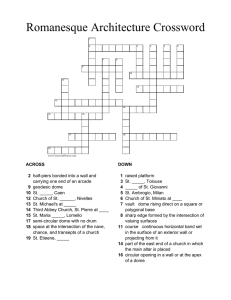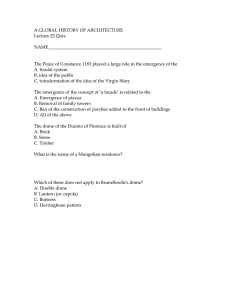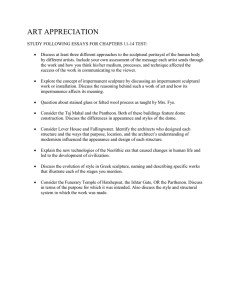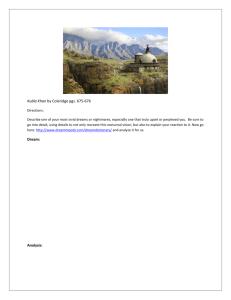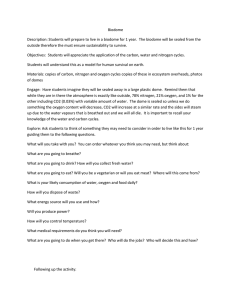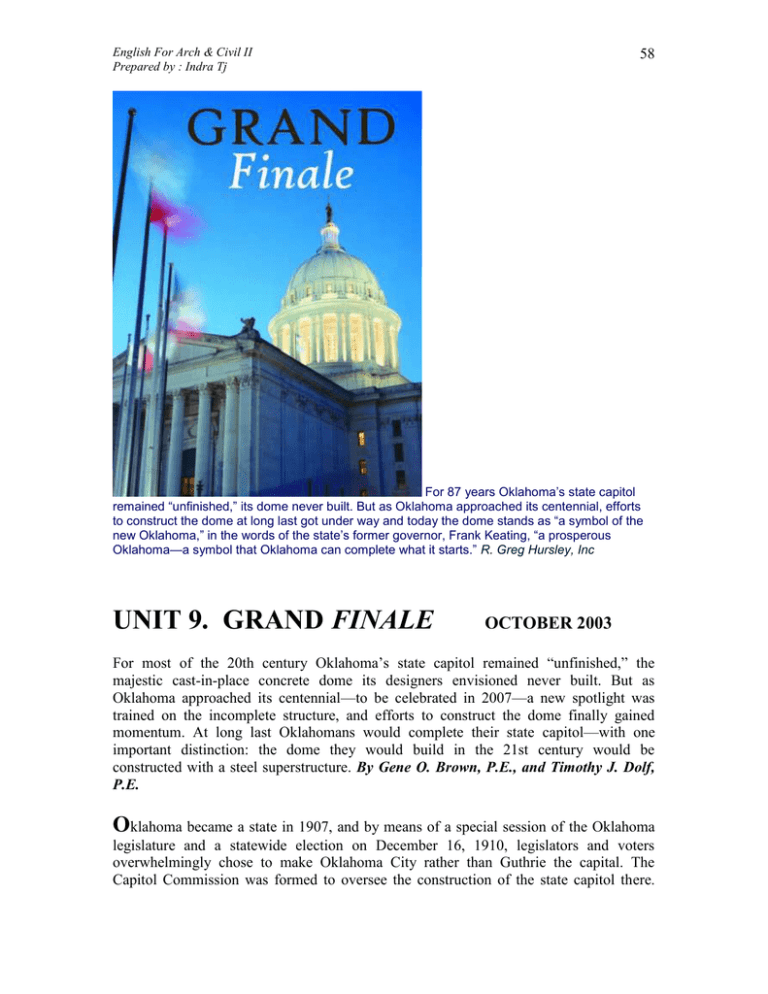
English For Arch & Civil II
Prepared by : Indra Tj
58
For 87 years Oklahoma’s state capitol
remained “unfinished,” its dome never built. But as Oklahoma approached its centennial, efforts
to construct the dome at long last got under way and today the dome stands as “a symbol of the
new Oklahoma,” in the words of the state’s former governor, Frank Keating, “a prosperous
Oklahoma—a symbol that Oklahoma can complete what it starts.” R. Greg Hursley, Inc
UNIT 9. GRAND FINALE
OCTOBER 2003
For most of the 20th century Oklahoma’s state capitol remained “unfinished,” the
majestic cast-in-place concrete dome its designers envisioned never built. But as
Oklahoma approached its centennial—to be celebrated in 2007—a new spotlight was
trained on the incomplete structure, and efforts to construct the dome finally gained
momentum. At long last Oklahomans would complete their state capitol—with one
important distinction: the dome they would build in the 21st century would be
constructed with a steel superstructure. By Gene O. Brown, P.E., and Timothy J. Dolf,
P.E.
Oklahoma became a state in 1907, and by means of a special session of the Oklahoma
legislature and a statewide election on December 16, 1910, legislators and voters
overwhelmingly chose to make Oklahoma City rather than Guthrie the capital. The
Capitol Commission was formed to oversee the construction of the state capitol there.
English For Arch & Civil II
Prepared by : Indra Tj
59
The noted architecture firm Solomon Layton and S. Wemyss Smith was selected to
design the structure, and 8 acres (3.2 ha) of farmland several miles northeast of the
downtown area were donated as the site of Oklahoma’s new government seat.
The plans developed by the architects in 1914 favored a neoclassical design and called
for the reinforced-concrete structure to be crowned with a 140 ft (42.7 m) cast-in-place
concrete dome. Unfortunately, World War I had begun, and the money, labor, and
materials needed to fully complete the structure were diverted to the war effort. As a
stopgap solution, a saucer dome—a cast-in-place concrete dome that, viewed from the
interior of the building, gave the appearance of a shallow dome—was put in place.
Commission meeting minutes reveal, however, that commissioners considered the idea of
constructing the saucer dome from steel to facilitate later demolition. Ground was broken
on July 14, 1914, and the state took occupancy of the building on June 30, 1917. The cost
of construction had totaled just over $2 million.
In July 2000, the state’s governor, Frank Keating, announced the success of fund-raising
efforts to pay for the construction of a new $21-million dome as part of the state’s
centennial celebration efforts. For the better part of a century, Oklahoma’s capitol had
remained “unfinished,” the only state capitol in the United States originally designed with
a dome not to have one. At a ceremony on June 20, 2001, at which he gave the order to
raise the dome’s first structural column, Keating observed that “the dome is a symbol of
the new Oklahoma, the prosperous Oklahoma—a symbol that Oklahoma can complete
what it starts.”
Backed by private donations, the Oklahoma Department of Central Services began to
develop the project, the state’s first major design/build contract. The new dome was
designed and engineered by Frankfurt-Short-Bruza Associates, P.C., an architecture,
engineering, and planning firm located in Oklahoma City. The new dome was
constructed by Capitol Dome Builders, a joint venture of Manhattan Construction
Company and Flintco, Inc., both of Oklahoma City. Statehood Day—November 16,
2002—was seen as a fitting date for the dedication ceremonies. The construction team
determined that 19 months would be required for construction, which meant that
construction had to begin by April 2001. Such a schedule allowed only six months for
site investigation, architectural design, and engineering.
The plans for the new dome called for an outer dome of precast concrete and cast stone, a
structural steel frame, and an inner, coffered dome of glass-fiber-reinforced plaster panels. The
photograph below was taken from the grand staircase looking up into the coffered dome. The
color scheme was inspired by the state flower, the gaillardia. The backlit stained glass state
seal is clearly visible through the oculus, right. R. Greg Hursley, Inc., both
English For Arch & Civil II
Prepared by : Indra Tj
60
The initial efforts of the design/build team were directed toward verifying the findings of
the feasibility studies carried out before the fund-raising efforts. Thanks primarily to the
Oklahoma Historical Society’s meticulous preservation of the original ink-on-linen
construction drawings, project specifications, construction photographs, and Capitol
Commission meeting minutes, this verification process was not as complicated as it might
have been. Although the construction documents would be considered incomplete by
today’s standards, they proved to be an invaluable resource during both the investigative
phase and the design process. The original documents included just 1 structural drawing
and 5 architectural drawings for the dome; by contrast, 71 drawings were required to fully
develop and construct the dome.
The capitol was constructed as a five-story, cast-in-place concrete frame on a spread
footing foundation that incorporated approximately 13,000 cu yd (9,942 m3) of handmixed concrete. A review of the historical documents revealed that while there were
actually four different foundation plans, only three were included in the preserved set of
drawings. The first two foundation plans were based upon the support of the saucer dome
and the large dome and utilized an allowable bearing pressure of 4,500 psf (215.5 kPa).
The third foundation plan was for the support of the saucer dome and took advantage of a
revised allowable soil bearing pressure of 6,500 psf (311.2 kPa). Several exploratory
studies were performed to determine which of these plans had actually been used in
construction.
By core drilling through the foundations and into the foundation bearing strata, laboratory
testing was able to provide engineering data based upon modern testing procedures.
Through strategic core drilling locations it was determined that each of the four central
spread footings in the core area was 28 ft (8.5 m) wide, 38 ft (11.6 m) long, and
English For Arch & Civil II
Prepared by : Indra Tj
61
approximately 5 ft (1.5 m) thick. Although the size of the footing did not correspond to
any of the three preserved foundation drawings, the dimensions did appear to correspond
to the expected size of the footing required to support the large dome with the increased
allowable bearing value. The size of the footing helped establish that the engineering of
the foundation had been based upon the higher bearing value and further indicated that
the existing structure had a built-in allowance for the 140 ft (42.7 m) tall cast-in-place
concrete dome. Moreover, the soil testing performed on the bearing strata indicated that
the allowable bearing value could have increased another 54 percent, to 10,000 psf (478.8
kPa).
Additional documentation was found indicating that the structure was intended to support
the large dome. Capitol Commission meeting minutes supported the exploratory testing
results but by themselves did not provide proof, since no one could be sure that all of the
minutes had been preserved. Capitol Commission minutes dated June 8, 1914, indicated
that the contractor was “directed to furnish columns for supporting the dome in
accordance with [the] design for the high dome.” The columns alluded to in the meeting
minutes were the rotunda columns, which would support an octagonal “ring beam” 100 ft
(30.5 m) above the basement level. This 5 ft (1.5 m) thick, 80 ft (24.4 m) diameter castin-place concrete ring beam was constructed to support the future dome framing. The
physical dimensions of the rotunda columns and ring beam matched the drawings for the
large dome. Historical photographs of the ring beam and columns taken during
construction confirmed the total number and layout of the reinforcing bars shown in the
original construction drawings for the large dome.
The state took occupancy of the domeless state capitol on June 30, 1917, and for the remainder
of the 20th century it remained as it appears in this 1936 photograph: incomplete.Courtesy
Oklahoma Historical Society
English For Arch & Civil II
Prepared by : Indra Tj
62
Having confirmed the physical dimensions of the existing structure, the architects and
engineers were able to begin designing the new dome. Their focus shifted to determining
the existing structural design properties. The original construction specifications
indicated the mix proportions for the concrete as “one part cement, two of sand, and four
of rock” and stated that “all concrete that is reinforced is to be what is known as sloppy
consistency—that is, so thin that it will run off the shovel if not handled rapidly.” The
original specifications further stated that “concrete in footings and foundation walls is to
be somewhat stiffer,” indicating less water in the concrete mix. To determine actual
concrete compressive strengths, 4 in. (101.6 mm) diameter core samples were taken from
numerous concrete beams, columns, and footings. Laboratory tests indicated that the
concrete compressive strengths were fairly consistent and averaged 1,610 psi (11,101 kPa)
in the superstructure and 3,270 psi (22,547 kPa) in the foundations. The higher
compressive strength in the footing was expected because typically less water is
associated with higher concrete strength. Additionally, samples of the steel reinforcing
bars were carefully removed from strategic locations. Steel reinforcing bars existed in
various shapes, including square, twisted square, deformed round, and smooth round bars.
Testing of the reinforcing steel consistently indicated a yield strength of 49,000 psi
(337,855 kPa). Although the cast-in-place concrete compressive strengths were much
lower than those seen today, the structural members were much more massive.
The information gathered during the investigative stage provided strong evidence that the
structure had indeed been designed for the anticipated loads associated with the large
cast-in-place concrete dome. The team proceeded on this basis. One of the greatest
challenges the construction of the dome presented, however, was the stipulation that the
building remain fully operational during construction and that all historical documents
and murals be protected from construction activities and the elements. The design/build
team developed a construction plan that addressed the challenges by incorporating
required construction sequences into the design of the dome. This incorporation would
have been virtually impossible had the project been constructed in accordance with the
conventional design/bid/build process. The design/build approach brought team members
together early in the design process and helped them resolve constructability concerns
long before problems arose.
English For Arch & Civil II
Prepared by : Indra Tj
63
This construction photograph of the south facade of the capitol shows the scaffolding being
removed and the temporary weather-resistant enclosure in place over the lower portion of the
drum.Frankfurt-Short-Bruza
Although the existing structure is of cast-in-place concrete, the team determined that the
new dome would be constructed with a steel frame. The decision to change structural
systems was based upon a 60 percent reduction in weight as well as a reduction in
constructability constraints. The weight of the new dome was a concern for several
reasons, the most salient being the associated increase in seismic force. The new dome
itself would comply with current seismic provisions; however the existing structure was
not believed capable of resisting the potential seismic loads because it could not be
retrofitted to meet seismic detailing requirements. Demolition of the cast-in-place
concrete saucer dome removed approximately 2 million lb (907,200 kg) of original
construction materials, and new construction added nearly 5 million lb (2.27 million kg).
The 3 million lb (1.36 million kg) net increase meant an increase in the overall building
weight of slightly more than 4 percent.
English For Arch & Civil II
Prepared by : Indra Tj
64
Developing accurate wind pressures was a challenge because a hemisphere constructed
above a colonnaded cylinder is not addressed in the building codes. Exterior columns,
building features, and nearby structures further complicated matters. The team
determined that wind tunnel testing would be prudent to validate the interpreted wind
pressures. A wind tunnel consultant constructed a 1:175 scale model encompassing the
entire capitol structure and all other structures within a 1,640 ft (500 m) radius. The
model, complete with 88 pressure taps, was placed on a turntable so that pressures could
be determined for wind coming from 16 different directions. Since testing was performed
on a small scale, the actual air speed in the wind tunnel was reduced to 42 mph (67.6
km/h), and the resulting wind pressures were sampled over a period of 60 seconds.
Multiple periods were then averaged to provide mean external pressure coefficients based
upon elevation and azimuth with respect to the wind direction. The wind tunnel testing
also provided the maximum inward and outward external pressures for use in designing
the dome’s components and cladding. Although wind tunnel testing indicated wind
pressures lower than those interpreted from the building codes, it was decided to use the
building code pressures during design
In addition to lateral loads, several types of gravity loads were considered. Preliminary
calculations indicated that snow, ice, and code-prescribed roof live loads would not
significantly control the design of the final structure. Through meetings and
conversations on constructability issues, construction sequences and the associated
imposed loads were evaluated. Since the new dome did not have any elevated floors on
which work could be staged, two temporary platforms were designed to support
scaffolding, demolition debris, and construction materials.
The lower work platform was built with conventional scaffolding supported at the fourth
floor of the existing structure and was decked with plywood. This platform facilitated
demolition of the saucer dome down to the ring beam level and protected the occupied
area below from the demolition debris. Isolated demolition of the concrete saucer dome
was performed so that the steel columns that would form the new dome’s colonnade
could be installed. The upper work platform was then supported above the saucer dome
and attached to these columns. The 16 radial beams supporting the upper work platform
were placed so as to project through the 16 future window openings. Since the windows
could be installed later in the construction schedule, the work platform could remain in
place during much of the construction process.
The upper work platform was approximately 110 ft (33.5 m) square in plan and was
designed to support a 50 psf (2.39 kPa) live load. The platform was constructed with a
waterproofing membrane sandwiched between two 2 in. (50.8 mm) thick concrete slabs
reinforced with polypropylene fiber. Scaffolding was set along the perimeter of this
platform to finish erecting the structural steel frame and the precast-concrete and cast
stone veneer. Hatches were constructed in the upper work platform to remove demolition
debris from below and lower construction materials from above. Portions of this platform
could then be removed in stages to allow the drum of the dome to be constructed through
the platform. Eventually, each of the radial beams was removed through the window
English For Arch & Civil II
Prepared by : Indra Tj
65
openings and the scaffolding from the lower platform was extended upward so that
construction of the inner dome could proceed.
The need to protect the building, its occupants, and the valuable artwork dictated much of
the construction sequencing and required the use of temporary weather-resistant
enclosures. To protect the interior artwork from moisture, a temporary structure was built
from the upper work platform down to the existing roof, 26 ft (7.9 m) below. The
weather-resistant structure was sealed around the new dome columns and remained until
the dome was substantially complete and weatherproof. The temporary enclosure
appeared as a white metal box covering the lower portion of the drum.
Isometric View of the Precast-Concrete Connection
Section through the Precast-Concrete Dome Panels
Frankfurt-Short-Bruza
English For Arch & Civil II
Prepared by : Indra Tj
66
From the construction sequencing required for the work platforms and scaffolding, the
team determined that the governing gravity load case would be the construction loads and
the potential for additional ice to accumulate on the scaffolding during the winter. The
scaffolding itself weighed 120,000 lb (54,432 kg), and that weight would then be equaled
by the weight of the construction materials that would be staged on the platforms. By
working with the contractor’s construction requirements and sequencing, engineers
determined realistic construction loads and incorporated them into the structural design of
the dome. This incorporation of the construction requirements was facilitated by the
design/build process, and the preplanning efforts undertaken by members of the
design/build team reduced the cost of construction
The plans for the new dome called for an outer dome of precast concrete and cast stone, a
structural steel frame, and an inner, coffered dome of glass-fiber-reinforced plaster panels.
The dome would be 80 ft (24.4 m) in diameter and rise 140 ft (42.7 m) above the existing
roof, and the lantern would be capped with a 17 ft (5.2 m) tall, 6,000 lb (2,722 kg) bronze
statue of a Native American entitled The Guardian. Spiral staircases, catwalks, and
ladders would provide internal access all the way to the cupola level at the base of the
lantern, where anchors were provided for exterior maintenance. At the inner dome,
certain coffers are removable and contain hoists to aid in such interior maintenance as
cleaning and lightbulb replacement. Additional project elements included a state-of-theart dome lighting system that can be adjusted to produce infinite color variations and a
supplemental system by which smoke can be removed from all parts of the building
through the oculus of the inner dome.
Much of the structural framing was dictated by the dome’s architectural features. The
dome’s proportions and the number of exterior columns and exterior windows were fixed
on the basis of the five architectural sheets provided in the original construction
documents. Every attempt was made to adhere to the intent of the original plans; however,
modern construction techniques dictated numerous changes. The selected framing
scheme consisted of an interior ring of 16 W14X176 (W360X262) wide-flange columns
that are vertically braced above and below the windows in the drum. The exterior ring
consists of 16 pairs of 12 in. (305 mm) diameter pipe columns, which are wrapped in
precast concrete and form the colonnade. At the top of the columns a concrete-on-steel
deck platform forms the oculus of the interior dome and serves as the tension ring and
diaphragm at the base of the exterior dome. Sixteen arched W10X49 (W250X73) wideflange columns extend from this platform to form the dome and tie in at the compression
ring located just below the lantern at the cupola level. A 20 ft (6.1 m) tall, 36 in. (914 mm)
diameter steel pipe with a cap plate extends upward through the lantern to support the
base of the statue. This steel pipe was fitted with interior ladder rungs so that a worker
could climb into the pipe and tighten the bolts that anchor the statue when it was raised to
its final position, which occurred on June 7, 2002.
The new structural steel frame was designed and the original cast-in-place central core
was verified with the aid of three-dimensional structural modeling software. Owing to the
complexity of construction and the construction loads imposed, several three-dimensional
models were developed to depict the structure at various critical stages of construction.
English For Arch & Civil II
Prepared by : Indra Tj
67
These computer models incorporated concrete members for the existing frame, steel
members for the new frame, and finite elements for the verification of the existing
foundation and ring beam. The final model contained 1,704 joints, 2,389 elements and
members, and 452 spring supports. The three-dimensional model was simplified by
utilizing the biaxial symmetry of the structure whenever possible. In addition, much of
the member and joint input was simplified by importing digital exchange format (DXF)
files from the computer-aided drafting software. A P-Delta analysis was performed, and
since the number of load combinations was kept to a minimum, the computer’s required
calculation time was not significantly increased.
The structural modeling software was used to design the structural steel frame; however,
it was not used to verify the capacity of the existing concrete structure. Governing force
envelopes were determined for the existing concrete members and compared with their
capacities as determined by hand calculations. Determining the capacity of the existing
members was yet another of the many challenges encountered while verifying the
adequacy of the existing structure. Rebar scanning equipment was unable to verify the
amount of reinforcing steel in the concrete slabs and beams. The available construction
photographs, although limited in number, indicated that construction had adhered to the
original construction documents. Additionally, the photographs provided evidence that a
portion of each floor had been load tested to 200 percent of the design loads. While
checking the existing rotunda columns, which would support the new dome, the team
determined that they contained two independent circular rebar cages that had been cast
together side by side in a single rectangular column. Many hours were spent rationalizing
the true axial capacity of such a detail. Fortunately, when it was determined that the
column could be treated as two independent columns, it was found that the existing
columns would provide adequate capacity for the dome
English For Arch & Civil II
Prepared by : Indra Tj
68
In this construction photograph, taken from the tower crane during the early stages of the precastconcrete erection, the weather-resistant enclosed work platform is visible at the lower portion of
the dome’s drum. The tower crane was the tallest freestanding tower crane ever erected in
Oklahoma. The crane’s hook could be raised 270 ft (82.3 m) above the ground and had a reach
of 230 ft (70.1 m)—past the farthest extremity of the dome. Capitol Dome Builders
The maximum story drift was limited to the height divided by 300 and was governed by
the drum section of the dome. Since X-bracing would have conflicted with the windows
and further complicated the framing, a partial-height curved concrete shear wall was
added to help stiffen the lower portions of the columns forming the drum of the dome.
The final structural models and calculations indicated that the dome’s horizontal drift
would be approximately 1.6 in. (40.6 mm) under a design seismic event and 1.4 in. (35.6
mm) under the design wind loads.
To preserve the strength of the existing concrete ring beam, it was imperative that
existing rebar not be cut during the installation of anchor bolts for the new columns. By
locally chipping down to the top mat of existing reinforcement and drilling small pilot
holes to locate existing lower mats of reinforcement, acceptable anchor bolt locations
could be determined for the 352 anchor bolts. Templates for each anchor bolt pattern
were created, and 48 unique base plates were fabricated and field welded to the columns.
Aside from the engineering challenges involved in renovating an 87-year-old structure,
the team encountered challenges associated with the finish materials. The existing
structure was wrapped in limestone from a quarry no longer in production. In addition,
the limestone was weathered and would have been very difficult to match with natural
materials. Concerned that the construction cost would exceed the budget and that the
limestone would not match, the team opted for architectural precast concrete and cast
stone for the dome’s exterior. Several concrete samples were produced—in varying
colors and with varying degrees of sandblasting—from which the final mix design was
selected.
To address concerns regarding the required maintenance of the sealed precast panel joints,
a detail was developed through coordination with the fabricator of the precast-concrete
panels in which precast ribs were placed over the vertical joints of the dome panels. As an
added precaution, all inside faces of the precast panels would be accessible. This
accessibility would help prevent damage to the original artwork and inner dome below
from undetectable leaks. It would also facilitate repairs to the interior face of the outer
dome.
English For Arch & Civil II
Prepared by : Indra Tj
69
In this construction photograph, taken from the tower crane, the dome exterior appears to be
nearly complete. Capitol Dome Builders
The precast-concrete panels were attached to the steel ribs at the quarter points of the
panels, with the top and bottom ends left unsupported. Attachment was made with
stainless steel pipes and plates. Since only half of a panel’s expansion or contraction
would be restrained between the outermost pipe connections, this connection method and
layout helped reduce the forces applied to the steel frame when subjected to thermal loads.
Approximately 4,500 pieces of precast concrete and cast stone—totaling 1,700 tons
(1,542.2 Mg)—were erected in levels, the first visible construction starting at the base of
the dome. As soon as each level was completed, the scaffolding would rise to support the
next level of construction. This staging continued until the base of the statue was reached.
Instrumental in the success of the project was the tallest freestanding tower crane ever
erected in Oklahoma. The crane’s hook could be raised 270 ft (82.3 m) above the ground
and had a reach of 230 ft (70.1 m)—past the farthest extremity of the dome. The most
significant load during construction was the placement of a 10,000 lb (4,536 kg) piece of
precast concrete at the far side of the dome, 180 ft (54.9 m) from the tower. The crane
boom deflected downward approximately 4 ft (1.2 m) during the lift. The crane’s
foundation consisted of 5 ft (1.5 m) wide by 8 ft (2.4 m) thick concrete beams supported
by four 48 in. (1,219 mm) diameter drilled piers that were spaced 22 ft (6.7 m) apart. The
English For Arch & Civil II
Prepared by : Indra Tj
70
piers were embedded more than 25 ft (7.6 m) into the hard shale bedrock to resist design
uplift loads expected to exceed 300,000 lb (136,080 kg).
Thousands of Oklahomans convened to dedicate the new dome on Oklahoma’s Statehood
Day, November 16, 2002. The project was completed on time and within budget and was
dedicated with a spectacular show that culminated in a fireworks display unlike anything
ever witnessed in Oklahoma. Today the dome stands tall in Oklahoma City and is a
symbol of the pride that Oklahomans take in, as the former governor put it, completing
what they start.
Gene O. Brown, P.E., and Timothy J. Dolf, P.E., are project structural engineers for
Frankfurt-Short-Bruza Associates, P.C., in Oklahoma City. For additional information on
the dome project, visit www.oklahomadome.com.
Project Credits
Owner: Department of Central Services, State of Oklahoma
Architect and engineer of record: Frankfurt-Short-Bruza Associates, P.C., Oklahoma
City
Contractors: Capitol Dome Builders, a joint venture of Manhattan Construction
Company, Oklahoma City, and Flintco, Inc., Oklahoma City
Architectural precast concrete engineering and manufacturer: Arkansas Precast
Corporation, Jacksonville, Arkansas
Demolition subcontractor: Midwest Wrecking, Oklahoma City
Field-testing consultant: Standard Testing & Engineering Company, Oklahoma City
Structural steel fabricator: H&M Steel Corporation, Luther, Oklahoma
Photographers: Frankfurt-Short-Bruza Associates, P.C., Oklahoma City, and R. Greg
Hursley, Inc., Austin, Texas
Waterproofing consultant: Hoffman Architects, New York City
Wind tunnel testing: Letchford, Norville, Schroeder, Smith and Associates PLLC,
Lubbock, Texas
CE Magazine Table of Contents | ASCE Publications Home Page | ASCE Home Page
Copyright © 2003 ASCE. All rights reserved.
English For Arch & Civil II
Prepared by : Indra Tj
71
Grand Finale – October 2003 Civil Engineering Magazine
A. SKIMMING
Please read the Grand Finale from the Civil Engineering Magazine briefly, after that
you have to find the main essence of the article. By understanding the article it is
believed that you wont left behind the latest information about the Civil Engineering,
Architecture as well as the technology.
It is very important that you could find the essence, discussed among your members
of the group, later you could present in the front of class.
B. TRUE & FALSE
1. The Oklahoma Capitol Commission was formed to oversee the construction of the
State Capitol.
2. The Oklahoma plan was developed by the architect in a neoclassic design.
3. The reinforced concrete dome was structured to be crowned with a 140 ft cast-inplace concrete.
4. The viewed from the interior of the building, gave the appearance of a shallow
dome.
5. The cost of construction had totaled just over $ 4 million.
6. The dome is a symbol of the new Oklahoma, the prosperous Oklahoma-a symbol
that Oklahoma can complete what it starts.
7. The new dome was designed and engineered by Frank Lord Right.
8. The construction need more than 19 months.
9. The original documents included 1 structural drawing and 71 architectural
drawings for the dome.
10.The capitol was constructed as a fifteen-story.
11.By core drilling through the foundations and into the foundation bearing strata,
laboratory testing was not able to provide engineering data based upon modern
testing procedures.
12.The structure was intended to support the large dome.
13.The rotunda columns are supported an octagonal ring beam 30.5 meter above the
basement level.
14.The specifications are: one part cement, two of sand, and four of rock.
15.The higher compressive strength in the footing was expected because typically less
water is associated with higher concrete strength.\
16.The cast-in-place concrete compressive strengths were much lower than those seen
today, the structural members were much more massive.
17.The design team developed a construction plan that addressed the challenges by
incorporating required construction sequences into the design of the dome.
18.The existing structure is of cast-in-place concrete, as well as the dome.
19.The team cannot determine the result of the wind tunnel testing.
20.The wind tunnel testing also provided minimum inward and outward external
pressures for use in designing the dome’s components and cladding.
English For Arch & Civil II
Prepared by : Indra Tj
72
C. FILL IN THE BLANK BASE ON THE READING
1. Preliminary calculations ……………that snow, ice, and code-prescribed roof live
loads…………significantly control the design of the final structure.
2. Construction sequences and the associated imposed loads…………evaluated.
3. The lower work platform…………..built with conventional
scaffolding....................supported at the fourth floor of the existing structure
and ………..decked with plywood.
4. The upper work platform……………..then……………………above the saucer
dome and attached to these columns.
5. Each of the radial beams …….. removed through the window openings and the
scaffolding from the lower platform…………….extended upward so that
construction of the inner dome………………….proceed.
6. To protect the interior artwork from moisture,………………..structure was built
from the upper work platform down to the existing roof, 7.9 m below.
7. This incorporation of the construction requirements ………………..by the
design/build process, and the re-planning efforts undertaken by members of the
design/build team ……… the cost of construction.
8. The plans for the new dome …………an outer dome of precast concrete and cast
stone, a structural steel frame, ……..an inner, coffered dome of glass-fiberreinforced plaster panels.
9. The new structural steel frame………designed and the original cast-in-place
central core……………..verified with the aid of the three-dimensional structural
modeling software.
10. The structural modeling software……..used to design the structural steel frame.
D.
1.
2.
3.
4.
5.
6.
7.
FINDING THE INFORMATIONS BASE ON THE READING
Who is the owner of the New Building that has been mention above ?
Who are the architect and engineer of the building ?
Who are the contractors ?
Who is the precast concrete manufacturer ?
Who is the demolition subcontractor ?
Who is the engineer who did the report for the Civil Engineering Magazine ?
If you need more information about that building, what you have to do ?

